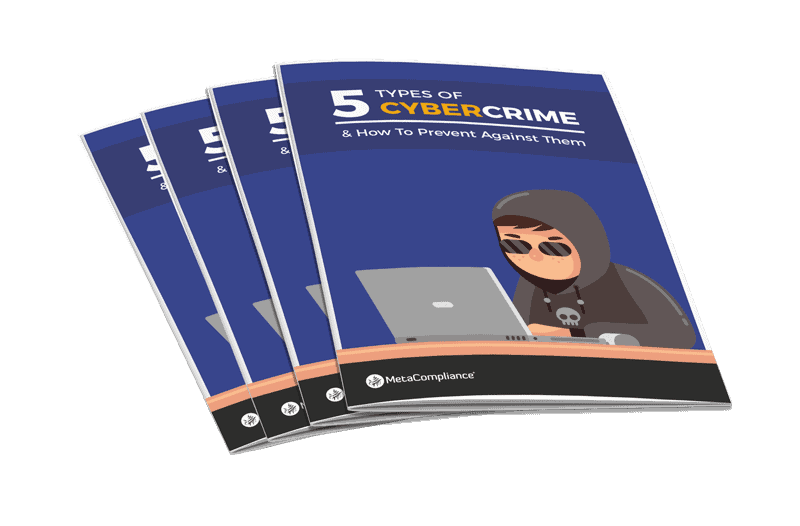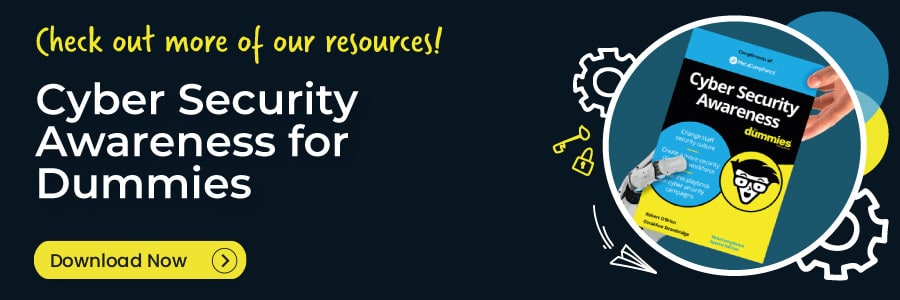5 Types of Cybercrime and How to Protect Against Them
Published on: 1 Jan 2019
Last modified on: 23 Jul 2025
Here we look at 5 common types of cybercrime, along with some practical tips on how to protect your organisation from them.
The Internet is a dangerous place. That’s because some tech-savvy individuals engage in various types of criminal activities online or by abusing computer networks. Those nefarious operations usually result in the theft of unsuspecting users’ personal or financial information, data which actors on the dark web monetize for their own gain.
In acknowledgement of European Cyber Security Month (ECSM), for which MetaCompliance has already created a guide on how to stay safe online and a resource for creating a security culture at the workplace, it’s important that users train themselves on how to recognize the common signs of cybercrime and protect themselves against those campaigns.
Here’s five types of cybercrime with which users should familiarize themselves.
Free eBook: 5 Types of Cybercrime & How to Prevent Against Them

Types of Cybercrime
Phishing
Phishing is a type of attack were actors attempt to trick unsuspecting users into doing something they wouldn’t ordinarily do, such as clicking on a malicious URL or email attachment. Actors usually leverage phishing attacks to steal users’ login credentials, details which they can then abuse to gain unauthorised access to their victims’ emails or financial accounts.
How to Protect against Phishing
Users can protect themselves against phishing by exercising caution around suspicious links or email attachments. They should also be on the lookout for other tell-tale signs of a phishing scam, like frequent grammar or spelling mistakes in what might seem to be an official piece of correspondence from a bank or other institution.
Learn more about phishing with the Ultimate Guide To Phishing
Ransomware
Ransomware is a subset of crimeware that in most cases infects a victim’s computer via phishing attacks or an exploit kit campaign. Upon successful infection, the ransomware commonly encrypts the victim’s data. It then demands a ransom payment in exchange for the return of their data. But that’s not set in stone. There’s no guarantee victims will ever get their data back.
In addition to following the anti-phishing steps laid out above, users should formulate a data recovery plan for their computers. Such a program will help ransomware victims recover their data for free if they ever experience an infection. As part of that plan, users should in the very least maintain two local backups to which they copy their data on a regular basis.
Malware
Malware comes in many different forms. Some specifically target users’ financial information by installing keyloggers onto victims’ computers. Malware samples can also reach users via a number of delivery methods, including phishing attacks and malicious software packages that exploit unpatched software vulnerabilities. Once installed, attackers can use the malware to spy on online activities, steal personal and financial information or hack into other systems. Malware has become one of the biggest online threats and it’s been used in some of the world’s largest cyber-attacks including WannaCry, NotPetya and Cryptolocker.
How to protect against Malware
People can protect against malware by always checking the domain of a login page for their web accounts. If something seems off, the website might be a fake and could attempt to steal users’ login information. Users should also implement security updates as soon as possible and store their passwords in a secure location such as a password manager.
Identity Theft
Attackers can do all kinds of things with a person’s identity. They can seize control of victims’ banking credentials, apply for new banking accounts, steal users’ hard-earned savings, and more. All they need are some key bits of information about you to convince a bank or a customer service representative that they’re you.
To protect against identity theft, users should take care not to reveal too much about themselves on social media and other websites. There is no reason to ever publicly disclose financial information. In addition, users should never use email to transmit their Social Security Number or other personal information to another person, especially someone they don’t know.
You should also read:
5 Ways to Identify a Phishing Website
Scams
Scams don’t come in one size. But many of them have something in common: they convey an enticing offer that in many cases attempts to trick users into sending over money. Of course, those offers are baseless, and victims end up losing money in the process.
In life, when something sounds too good to be true, it probably is. Users should never buy into incredible scenarios where they’re offered money or other rewards in exchange for a fee. Instead they should see those messages for what they are: campaigns designed specifically to steal their money. Below are some more tips to protect against types of cybercrime.
Conclusion
By exercising common sense and following security best practices, users can protect against phishing attacks, ransomware, malware, identity theft, scams, and some of the other most common types of cybercrime.
But as we all know, nothing is stagnant on the web. Cybercrime is continually evolving, which is why organizations must continually train their employees and help them build upon their awareness of IT security threats.
Additional reading:
What to do if you Click on a Phishing Link
How to Prevent Mobile Phishing Attacks
